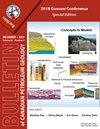Optimization of Variograms used for Truncated Plurigaussian Simulation
Q3 Earth and Planetary Sciences
引用次数: 1
Abstract
Abstract Stochastic simulation of facies is a continuing and important area of research. To increase model performance and reproduce realistic relationships between categories (facies), an understanding of the geometries and internal architecture of the domain is required. Modelling of spatial categorical data with truncated bi-Gaussian simulation and generating the required mask that reproduces the desired category’s spatial relationships is an important, initial step in categorical variable modelling. Truncated bi-Gaussian simulation is typically used when there are known, complex spatial relationships between the categories. Truncation rules based on thresholds applied to the Gaussian realizations (i.e. the mask) control the proportions and ordering of categories in the simulation. The choice of these thresholds has a large effect on the final models. This work describes a program that is developed for truncated Gaussian simulation where the truncation rules are linear, but are locally varying to account for locally varying proportions. The appropriate truncation rules are calculated based on the user supplied locally varying proportion maps. Moreover, an optimization framework to determine the input variograms used to generate the initial Gaussian realizations is presented. Initially, the optimization is brute force with the best set of variograms carried forward; the second local refinement step is important in obtaining reasonable bi-Gaussian models. A case study simulating rock types at a mineral deposit is presented to illustrate the implementation of the proposed methodology.截断多高斯模拟变差函数的优化
相随机模拟是一个不断发展的重要研究领域。为了提高模型性能并再现类别(相)之间的真实关系,需要了解领域的几何形状和内部架构。用截断的双高斯模拟对空间分类数据进行建模,并生成再现所需类别空间关系的所需掩模,这是分类变量建模中重要的第一步。截断双高斯模拟通常在类别之间存在已知的复杂空间关系时使用。基于应用于高斯实现的阈值的截断规则(即掩码)控制仿真中类别的比例和顺序。这些阈值的选择对最终模型有很大的影响。这项工作描述了一个为截断高斯模拟开发的程序,其中截断规则是线性的,但局部变化以解释局部变化的比例。根据用户提供的局部变化比例图计算适当的截断规则。此外,还提出了一个优化框架来确定用于生成初始高斯实现的输入变差。最初采用暴力优化方法,将最优方差集发扬下去;第二步局部细化对于得到合理的双高斯模型非常重要。本文以一个模拟矿床岩石类型的案例研究来说明所提出方法的实施。
本文章由计算机程序翻译,如有差异,请以英文原文为准。
求助全文
约1分钟内获得全文
求助全文
来源期刊

Bullentin of Canadian Petroleum Geology
Earth and Planetary Sciences-Geochemistry and Petrology
CiteScore
2.50
自引率
0.00%
发文量
0
期刊介绍:
The Bulletin of Canadian Petroleum Geology is a peer-reviewed scientific journal published four times a year. Founded in 1953, the BCPG aims to be the journal of record for papers dealing with all aspects of petroleum geology, broadly conceived, with a particularly (though not exclusively) Canadian focus. International submissions are encouraged, especially where a connection can be made to Canadian examples.
 求助内容:
求助内容: 应助结果提醒方式:
应助结果提醒方式:


